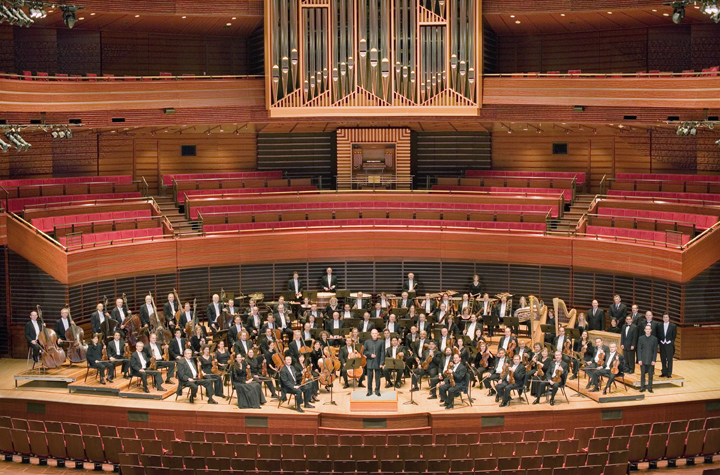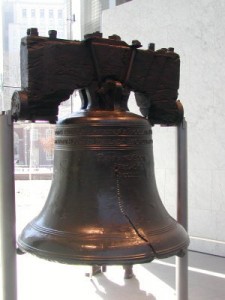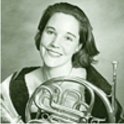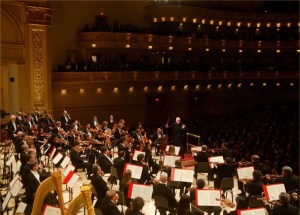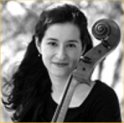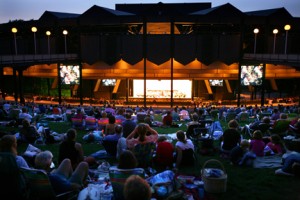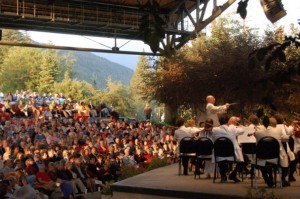The Philadelphia Orchestra
About the Orchestra
Philadelphia, ‘the City of Brotherly Love,’ was an early capitol of the United States and is the home of the Liberty Bell. It’s a city whose wealth has long been concentrated along a rail corridor (hence the name: Main Line), but it has colorful ethnic neighborhoods (think of South Philly) and has also been the site of fierce racial clashes. The Franklin Institute is in Philadelphia, as is the Philadelphia Museum of Art, the Academy of Music, the Curtis Institute … and The Philadelphia Orchestra.
That name says it all: The Philadelphia Orchestra. Three equal words. And those words have come to mean “a product of the highest quality.” The Philadelphia Orchestra.
The orchestra has a rich history and many traditions. As recently as the mid-1970s most of the players were Curtis graduates, every Monday was devoted to recording sessions in the historic Academy of Music, and the players wore business attire on the train to NY, where they performed 8 times a year. But “the times, they are a-changin’,” to quote Bob Dylan. Jim Undercofler, the former Dean of the Eastman School of Music (also the birthplace of Polyphonic) is the new President and CEO of The Philadelphia Orchestra. Christoph Eschenbach is stepping down, and Charles Dutoit has a four year appointment as Chief Conductor and Artistic Adviser while the music director search is carried out.
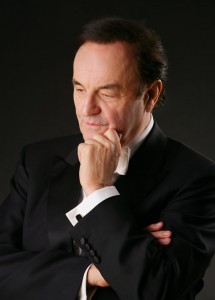
Charles Dutoit, Chief Conductor and Artistic Adviser (beginning in the 2008-09 season). Photo Credit: Chris Lee.
The orchestra’s first two music directors, Fritz Scheel and Carl Pohlig, are not as well known as the conductors who have led the orchestra more recently: Stokowski, Ormandy, Muti, Sawallisch, and Eschenbach; all of them are towering musical figures. Ormandy cultivated a sound particular to the orchestra, and the “Philadelphia sound” became world-famous. Many of the players were legendary too. At one time the principal winds were Marcel Tabuteau (oboe), William Kincaid (flute), Anthony Gigliotti (clarinet), Sol Schoenbach, (bassoon), and Mason Jones (French horn). The players who replaced them were often their former students, so the traditions were passed along.
Here are two paragraphs from the orchestra’s website about some of the “firsts” unique to Philadelphia:
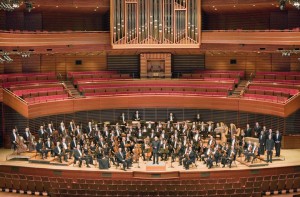
The Philadelphia Orchestra at Verizon Hall, The Kimmel Center for the Performing Arts. Photo Credit: Jessica Griffin.
Throughout its history, The Philadelphia Orchestra has introduced an unprecedented number of important works as world or American premieres, including Barber’s Violin Concerto, Mahler’s Symphony of a Thousand, Rachmaninoff’s Symphonic Dances, Schoenberg’s Gurrelieder, and Stravinsky’s Rite of Spring. Its illustrious tour history includes a number of landmarks events. In 1936 the Orchestra became the first American orchestra to undertake a transcontinental tour, in 1949 it toured Great Britain as the first American orchestra to cross the Atlantic after World War II, and in 1973 it became the first American orchestra to perform in the People’s Republic of China.
The Orchestra also boasts an extraordinary record of media firsts. It was the first symphonic orchestra to make electrical recordings (in 1925), the first to perform its own commercially sponsored radio broadcast (in 1929, on NBC), the first to perform on the soundtrack of a feature film (Paramount’s The Big Broadcast of 1937), the first to appear on a national television broadcast (in 1948, on CBS), and the first major orchestra to give a live cybercast of a concert on the Internet (in 1997).
Yvonne Caruthers, Senior Editor, July 2008
Organizational Change
Jim Undercofler, in his former position as Dean of the Eastman School of Music, was recognized nationally as being one of the leaders behind “organizational change” in the classical music world. I asked him what “organizational change” means in his new position as President and CEO in Philadelphia. His answer came quickly. “I think the biggest step we’ve been able to take so far is to come up with a mechanism that returns the artistic future of the orchestra to the orchestra’s hands, where I feel it belongs. My job is made easier by the fact that we have really good committees, and the leaders are excellent.”
Principal bassoonist Danny Matsukawa, who serves on the artistic committee, gave me the musician’s point of view of these changes. “We restructured our audition language. We got the music director to agree to equal veto power [at auditions], which changed things a lot.” The prior audition procedures made it theoretically possible for the audition committee to be unanimously in favor of a certain player, but the music director could veto their choice with his single vote. The new language says the music director needs the majority of the committee to agree with his choice of a candidate, and the committee needs the music director’s approval of their choice.
In describing the negotiations leading to these changes Danny commented, “There were tense moments, but in the end people realized the music director wouldn’t go too strongly against the committee. It also helps the musician coming in to know they had the blessing of both the music director and the committee. We’re [also] trying to make our committees larger – Berlin [Philharmonic] asks the whole orchestra to vote, and listening to an audition counts as a service. We might go in that direction, but we’re not quite ready for that – it’s costly. Without an actual music director in the next few years it’s not something we can work on right now.”
An orchestra’s search for a music director is always cloaked in secrecy as the stakes are very high for everyone involved. Jim Undercofler told me about the mechanics of Philadelphia’s current search. “We’re trying something a little different. We have 10 musicians and 9 board members on the search committee. The 10 musicians [on the committee] each have a group of musicians [in the orchestra] that they report to, so after we’ve had a guest conductor, the feedback comes from each group to their committee representative, and we meet every two months to talk about what we’ve learned. We’re never going to have 100% consensus from the players, but at least they will have had input. The board feels some urgency to finish the search, so that builds a certain tension into the process – between “getting it done” and wanting to hear everyone’s opinion.”
Raising the Invisible Curtain and Breaking the Glass Ceiling
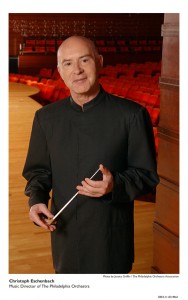
Christoph Eschenbach, Outgoing Music Director of The Philadelphia Orchestra. Photo Credit: Jessica Griffin.
Christoph Eschenbach, the orchestra’s outgoing music director, brought several ideas with him to “raise the invisible curtain” between the stage and the audience. Some of those ideas were very simple, such as having the orchestra turn to face the audience when they were asked to take a bow. Assistant principal cellist Yumi Kendall and Danny Matsukawa both mentioned pre-concert nervousness when it was their turn to talk to the audience about a Meet and Mingle session.
Yumi: “Musicians talk to the audience before tuning. Each section volunteers for a ‘Meet and Mingle’ with the audience after the show, and one member of that section tells the audience about it. I’ve had quite a bit of experience talking to an audience, but I was really, really nervous when it was my turn!” Danny added, “People like getting to know us as humans. When it was my turn to invite them to a ‘Meet and Mingle’ I referenced a rock concert, when the performers grab the mic at the end of the last song and say, ‘We love you! You’re the best!’ (I used to be in a punk rock group) so I told the audience the only way we could do that was for us to join them in the lobby after the concert.”
If Eschenbach worked to “raise the invisible curtain,” he also certainly broke “the glass ceiling” by hiring an unprecedented number of women, including a very young tuba player, Carol Jantsch, who hadn’t yet completed her undergrad studies at the University of Michigan when she won The Philadelphia Orchestra tuba audition!
Jennifer Montone, the orchestra’s new principal horn, talked about gender equality when I interviewed her. “I’m very fortunate that I had two major female horn players as role models growing up: Julie Landsman [at the Met] and Sylvia Alimena [in the National Symphony]. Hearing Sylvia and Laurel Ohlson in the NSO all the time, then studying with Julie and watching how she, and later also Susan Slaughter [a trumpet player], functioned as principal in a section, made being a woman brass player seem completely normal, and really helped give me great ideas about how to be a strong, gracious, and respectful colleague and leader. Hearing some of our older colleagues speak at the Women’s Brass Conferences made me appreciative of how much the world has changed, and how lucky we are that it is not so rare or so difficult anymore to be a female principal brass player, or a female executive for that matter! Women might lead sections a little differently than men do, but my section colleagues in the orchestras I’ve been in have always been very sweet, understanding, respectful, and patient with both my lack of experience and any gender differences there might have been.”
The Philadelphia Sound & Curtis
Wolfgang Sawallisch was music director when The Philadelphia Orchestra moved out of its old home, the historic Academy of Music, and into Verizon Hall at the Kimmel Center for the Performing Arts. Not only was it refreshing to have good news to read about during that momentous Fall of 2001, but the critics were unanimous that the new hall was a triumph – for the musicians as well as the audience. Danny Matsukawa disagrees. “People complained about the Academy, but it was ‘true’; what you heard was right. A bad reed sounded bad, and a great one sounded good. The new hall sounds more generic, and you can hear front-back but not across. The Academy was so dry that we had a thicker velvety sound because we had to. When we got to Carnegie it really showed. [In spite of that] I’m proud that we play a lot of different things well, not everything one way. We play Mozart in a very classical style, not like on the old Philly-Ormandy recordings, which had a thick sound. We respect the different styles and composers. Other orchestras are known for certain things – a great Bruckner orchestra, a great Mahler orchestra, but I think that we don’t play everything the same way.”
What about the “tradition” that most players in The Philadelphia Orchestra are graduates of the Curtis Institute? Is that still true? Yumi responded, “I don’t think so. My teacher at Curtis was not in The Philadelphia Orchestra. The orchestra coach was a member of the orchestra, that’s true, but most members of the string faculty are soloists, not orchestra players. I subbed with the orchestra for about two years before I graduated from Curtis, and I soaked up the orchestra’s sound, and how they do things, well before I got my job with the orchestra.”
Danny had a lot to say on this subject as well. ”[When I came to the orchestra] I was one of 11 new principals and associates and I was the only one who went to Curtis. Our concertmaster, harp, trumpet, trombone, bass, clarinet, etc, they didn’t go to Curtis. In the old days, if there were two finalists [at an audition] and one went to Curtis, they might have gotten the job. At a recent violin audition there were six finalists, three from Curtis, three who were not, and those three got the jobs. Sawallisch made a big difference, and so did Eschenbach. They made the orchestra more international. We have a high percentage of Curtis grads, but it’s not quite like it was 50 years ago. Tell people to audition for our orchestra – even if they didn’t go to Curtis!”
Recordings and New Media
The orchestra has always been known for its great recordings. Today they are in the forefront of “new media,” some of which are recordings, some of which are not. “We record for Ondine records,” Yumi told me. “We are releasing regularly. These are recorded ‘live,’ [which means they are] based on live performances, with no patch sessions (almost never). We have a ‘media guarantee’ payment in every check.”
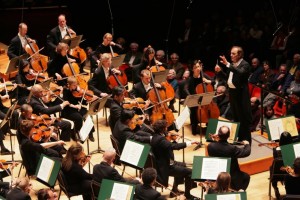
Chief Conductor and Artistic Adviser Charles Dutoit Leads The Philadelphia Orchestra in Verizon Hall, The Kimmel Center for the Performing Arts. Photo Credit: Chris Lee.
Jim Undercofler provided more details. “Electronic media is big here. We have an online store where people can download high quality recordings of the orchestra, not MP3s. We also have seven robotic cameras in the hall, and we work with a producer from the BBC to film our concerts for the Global Concert Series. Using Internet 2, we broadcast in very-close-to-real-time, to colleges and universities around the world. I went to the University of Delaware to watch what they did with the broadcast. They used a small recital hall, and they streamed the broadcast onto a screen so that the audience in Newark DE (it was a full house) could watch a “live” concert by the Philadelphia Orchestra.
“The Met has been doing this and it’s nice to be able to go to a theater to watch the Met on Saturday afternoon. I’ll use the example of Rochester NY. They have an opera company, which does 3-4 productions a year, so the Met broadcasts are supplemental to what they are doing. But most communities and cities have an orchestra of some sort and we don’t want to compete with that, so we feel colleges are our best market. We’re exploring getting our feet into retirement homes and nursing homes, but sometimes there are firewall issues since our bandwidth is so huge – we may have to wait for technology to catch up to us. The [orchestra] musicians have been very helpful – we need them to cooperate with us in this so we can explore new opportunities.”
Danny added, “They usually announce before the concert, ‘This concert is live on Internet 2, and it’s going to thousands of students.’ In the back of our minds we know it, but I hope we’re not doing anything different; every concert counts. We know we’re reaching a lot of people.”
Tradition and Playing Great Concerts
A global concert series, an online store for recordings, tours around the world (next year the orchestra will travel to the Canary Islands) – pretty glamorous stuff. But the day to day life in the orchestra centers around playing great concerts. I asked Jennifer Montone how it feels to follow in the footsteps of her illustrious predecessors, and whether she ever hears older players say, “I remember how Mason Jones played that solo…” She answered candidly, “It does affect me, both because there are a number of people in the orchestra who have been here since the ‘60s and ‘70s, and because Mason still comes to concerts every week! My section often goes to say ‘hi’ at intermission, especially because most of the others studied with him. People do tell me great Mason and Nolan [Miller, another former principal horn] stories, and I think about them often when I play: their interpretation of the horn as a solo voice, and especially about the section sound and style that they set up, and how it fit into the orchestra sound. I also think of them when I make leadership decisions. I think there’s a huge responsibility to being allowed to sit in that chair: you have to do it justice with your playing, and help the section grow and move forward, the way your predecessors did.”
Yumi Kendall, who was one of the younger players when she joined the orchestra four years ago, also spoke about the experience of playing with more senior players. “I try to learn from them, as well as welcome new ideas. I realized I was joining an orchestra with a strong history, so I have to respect where everybody’s coming from. I want to hear everyone’s story but I have to put my own story together.”
Community Engagement
When I asked about the orchestra’s “outreach initiatives,” I was a bit surprised to hear that The Philadelphia Orchestra’s efforts sound similar to that of many other orchestras around the country. Part of my surprise came because I didn’t hear even one comment suggesting an attitude of “I’m in The Philadelphia Orchestra, don’t ask ME to go play in a school!” I guess I shouldn’t have been surprised that even The Philadelphia Orchestra feels a need to attract younger, more diverse audiences.
Jennifer Montone: “I am enjoying getting involved in some of the donor and subscriber events that we have, and just played in my first set of “Sound All Around” concerts this past spring for 2-5 year olds, which was a blast! I like that there is such an emphasis here on “raising the invisible curtain” for all age categories. Our staff, our education department, and our teaching fellows really do a fantastic job of keeping our orchestra connected with the community.”
Yumi Kendall: “I’ve played in schools, given pre-concert lectures, and played chamber music performances. [At this year’s] residency in Vail, I’m playing at a farmer’s market with a quartet. Another day I’m playing solo cello at a hospital, and there will be Q&A with whomever is there.”
A different type of “outreach” has the orchestra directly influencing music education in the public schools. Jim Undercofler: “The Philadelphia Orchestra is the largest arts organization in the city. As such we have to be willing to use our clout for good purposes. We teamed up with the work the William Penn Foundation is doing, and because of our persuasion, the Philadelphia Public Schools have agreed to hire 40 more music teachers for next year.”
The Philadelphia Orchestra, with equal parts tradition and innovation, is leading the way into the 21st century. I’m going to let Jennifer Montone have the last word. “I think our orchestra is kind of amazing at combining the history and tradition and the strong community support we enjoy, with trying to break out of the mold: open-minded hiring, exploring new options in technology and media, etc. The organization seems to be very good at looking both forward and backward. Not just holding on to the past but also looking towards a creative future … what our field needs!”

